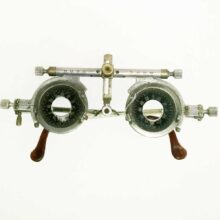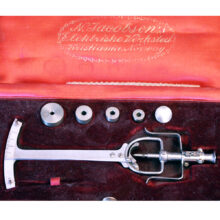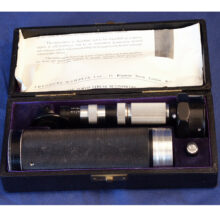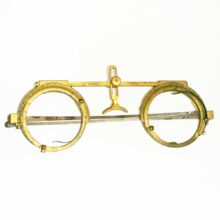Hertel mirror exophthalmometer by Handaya Co. of Japan
In 1905, Hertel commissioned an exophthalmometer to be made by Zeiss. This Hertel mirror exophthalmometer was made of brass and steel. It was able to measure the position of the eye in a forward and backward direction relative to the outer part of the eye socket.
There are two identical frames. One move along a connecting bar.
There are side rests that are placed so as to rest on the outer rim of the eye socket. Each frame has a long narrow mirror tilted at 45 degrees.
The doctor can see the image of the apex of the cornea in this mirror. A scale in millimeters is on the outer side of each frame.
This scale is reflected by a second narrow mirror.
The scale’s image is superimposed on the image of the corneal apex. When it was made in 1905, 20 mm was considered an average value for the corneal apex to stick out relative to the lateral orbital rim.
This more modern model was probably from the mid-1950’s to the mid 1960’s.
It was made by Handaya Co. of Japan and imported by a now defunct company called Optical Imports Co. of Bellingham, WA.
This example is unchanged from the model made for Hertel by Zeiss way back in 1905. It still works just fine today.
The box measures 10 1/2 inches by 4 inches by 1 1/2 inches.
Today’s exophthalmometers are made with prisms but still do the same thing. They are useful for tracking thyroid eye disease, orbital masses and other problems relating to the orbit (eye socket).










